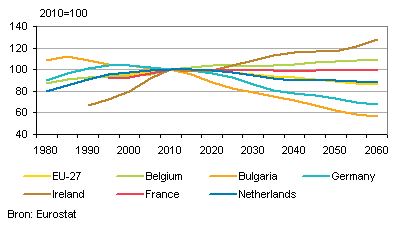The potential labour force of the European Union: from growth to decrease

Population growth in Europe has been decreasing for a number of decades now, an effect of the fall in the average number of children born per woman in the 1960s. Initially this was reflected in a decrease in the number of young people. Later it slowed down the growth of the potential labour force, i.e. the population aged 20-64 years. Now that the post-war generations are reaching retirement ages, the increase in the potential labour force is turning into a decrease.
On 1 January 2010, the total potential labour force in the 27 countries of the European Union numbered 307 million persons. This is 61 percent of the total population of the EU and is 20 million higher than in 1995. On the basis of Eurostat’s EUROPOP2010 population scenarios, the potential labour force is expected to fall to 265 million in 2060, 14 percent down on 2010. The proportion in the total population will then have dropped to 51 percent.
Population aged 20-64 years in some EU countries, 2010=100

Development of labour force in EU countries, change from 2010 to 2060

Developments differ between EU countries
There are substantial differences between the EU member states. In Bulgaria the number of 20-64 year-olds has been decreasing since the mid-1980s. In Germany, too, the decrease started before the turn of the century. In Ireland, on the other hand, the labour force has been growing relatively strongly, and is expected to do so up to 2060, when the number of 20-64 year-olds will be nearly thirty percent higher than it is now. In Germany and the countries in central and eastern Europe the potential labour force is expected to continue to decrease. In Bulgaria and Latvia this may be by as much as over 40 percent. In the Netherlands, the development of the potential labour force resembles that of the EU as a whole. In the period 1980-2010, the Dutch labour force grew by 20 percent, while in 2060 it is expected to be 12 percent smaller than in 2010.
UK and France set to overtake Germany
In absolute terms, Germany has by far the largest group of 20-64 year-olds: 50 million people. In 2060 this position will have passed to the United Kingdom, where the group will comprise 41 million people. France will also have overtaken Germany (37 million), while the size of the labour force in Italy will just about equal that in Germany (33 million people). The number of 20-64 year-olds in the Netherlands will be around 9 million, more than a million fewer than in 2010.
Changes in the potential labour force are caused partly by the number of children born and partly by migration. The high growth rate foreseen for Ireland is mainly based on the relatively high fertility rate there. In Germany the reduction as a result of the low fertility rate is somewhat tempered by immigration, but in Bulgaria and the Baltic states the opposite will take place: the decrease will be exacerbated by emigration. The increase in the UK labour force will be the result of a combination of relatively high fertility and high immigration. The highest immigration rates, however, are expected in Spain and Italy, where the reduction in the labour force will be limited.
Population aged 20-64 years in EU countries, 1995, 2010 and 2060

Nicole van der Gaag